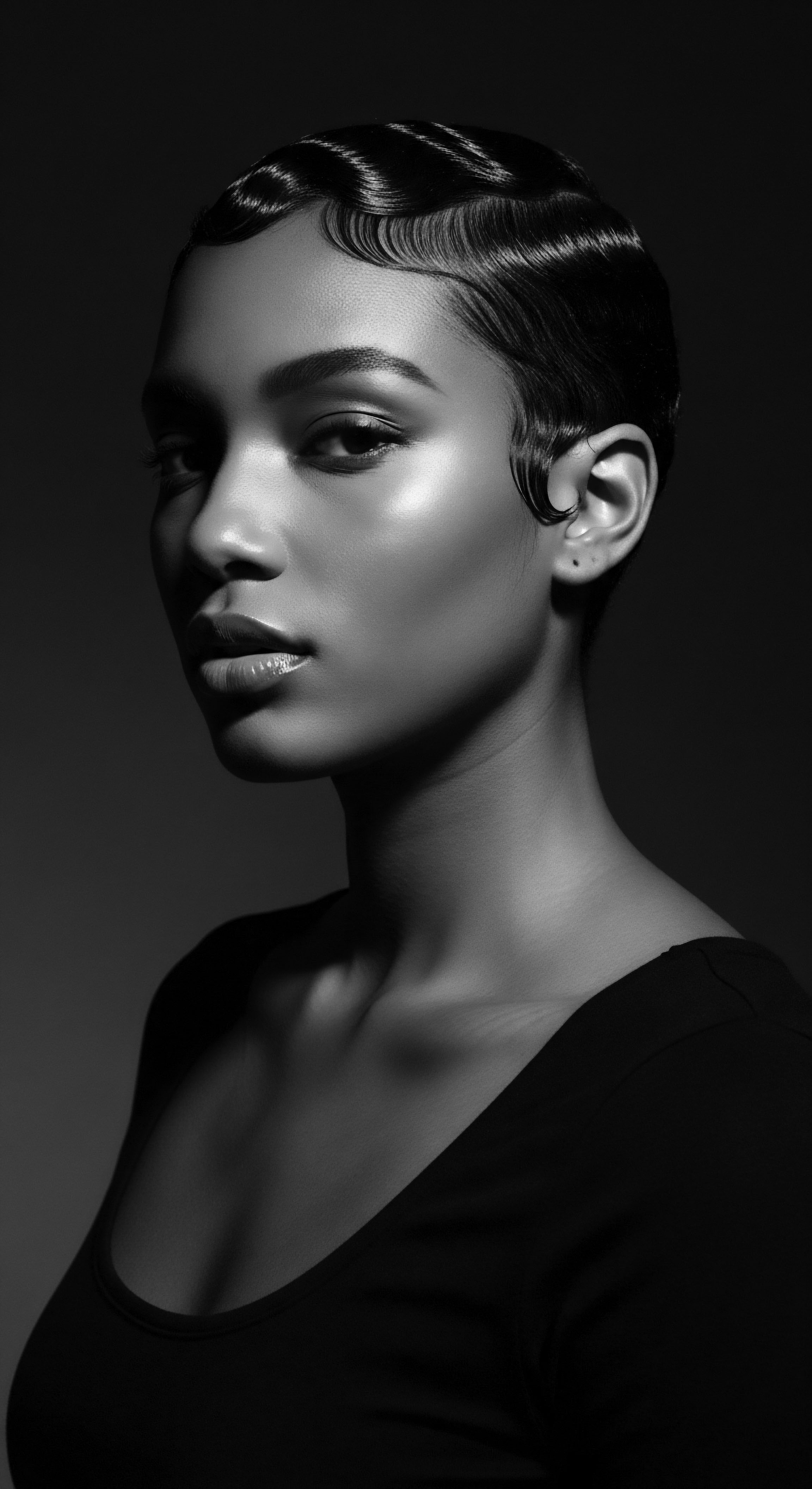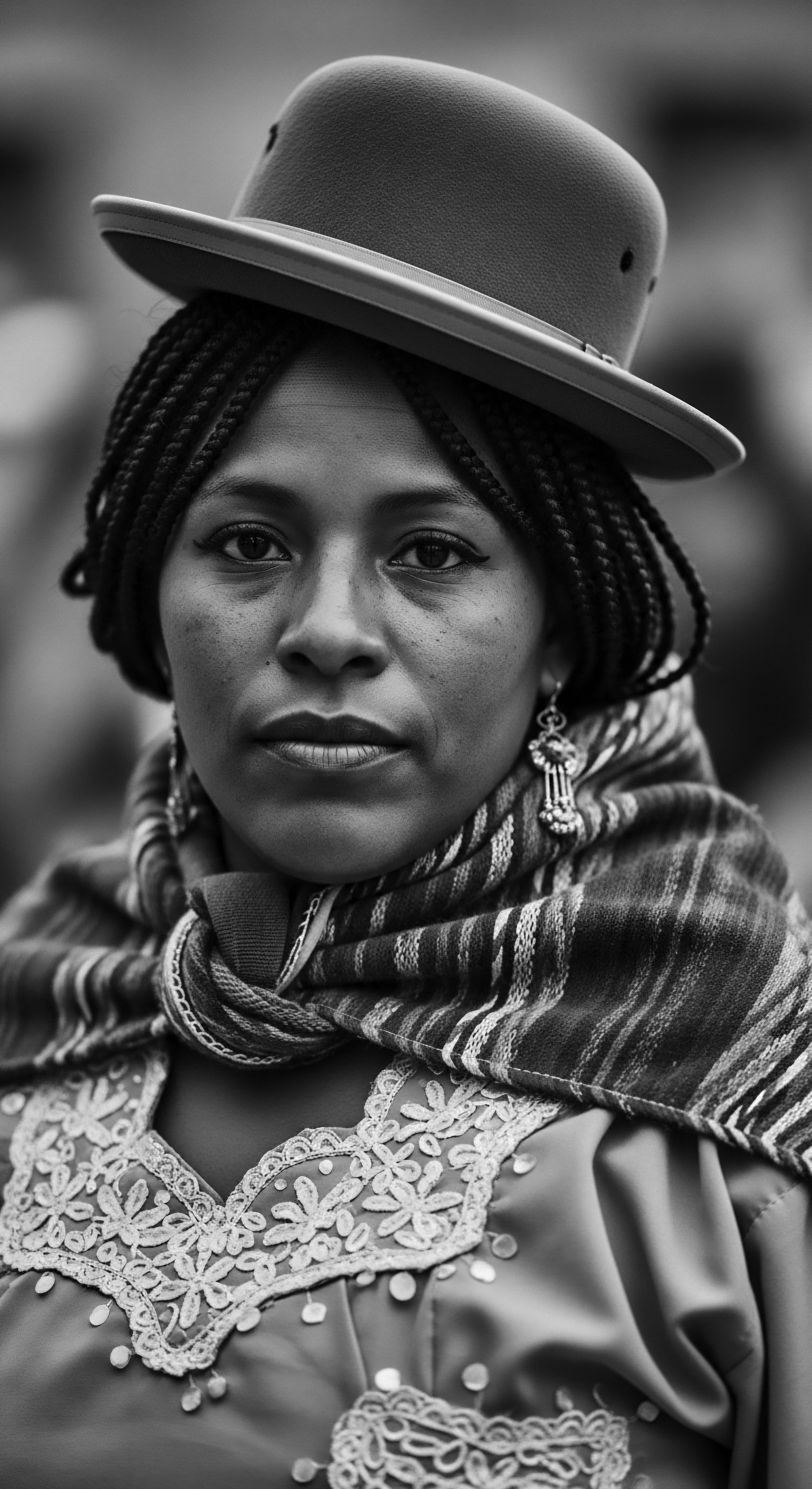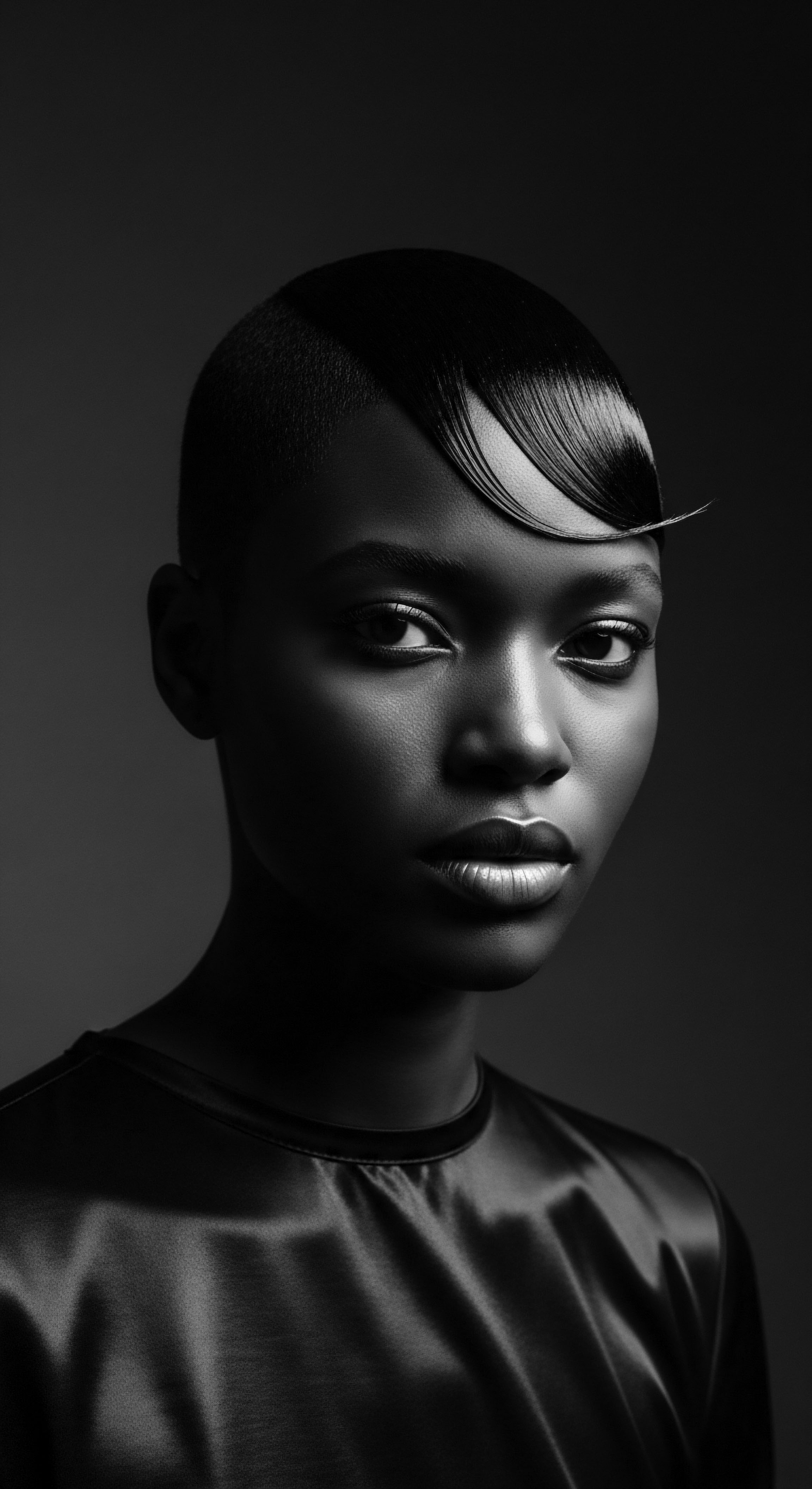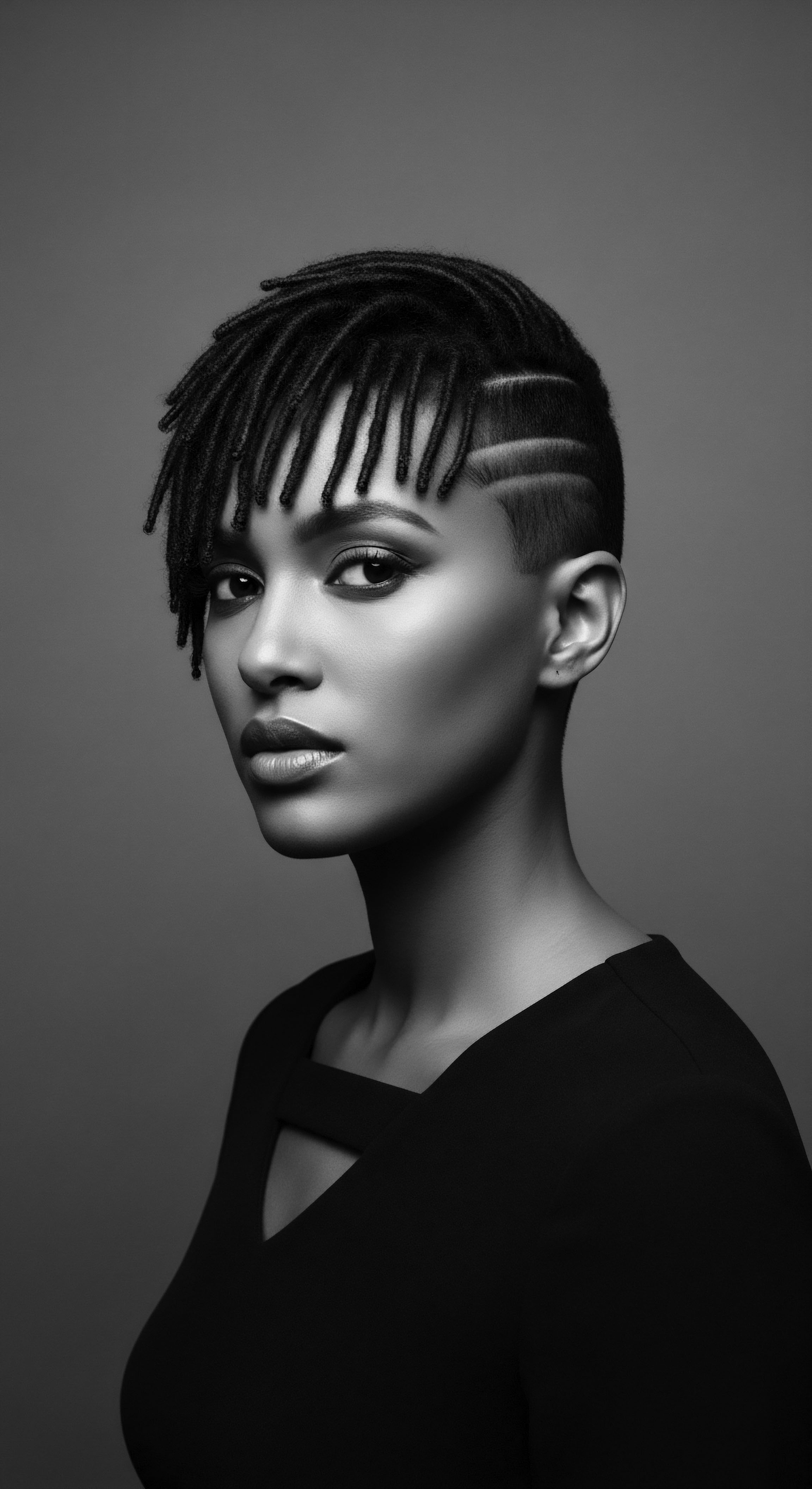
Fundamentals
The African Culture, when viewed through the lens of Roothea’s commitment to textured hair heritage, is not a singular, monolithic entity, but rather a vibrant, living mosaic of traditions, beliefs, and practices originating from the vast and diverse continent of Africa. Its fundamental meaning is deeply interwoven with the profound significance placed upon hair across countless ancestral societies. Hair, in this context, extends far beyond mere aesthetic adornment; it serves as a powerful conduit for identity, spirituality, social standing, and communal belonging. From the earliest recorded histories, African communities have meticulously styled and adorned their hair to communicate a rich tapestry of messages, making hair a visible language of lineage and life itself.
This foundational understanding reveals that the African Culture, particularly in its expression through hair, embodies a dynamic interplay between the elemental biology of textured strands and the sophisticated artistry of human connection. The unique characteristics of Afro-textured hair—its coil patterns, resilience, and capacity for intricate styling—were not simply accepted but celebrated and integrated into daily life and significant rites of passage. This historical appreciation stands as a testament to the ingenuity and deep respect for natural forms that characterized ancestral African societies.
African Culture, understood through its hair heritage, represents a living archive of identity, spirituality, and social connection, etched into every curl and coil.

Echoes from the Source ❉ Hair as an Ancestral Marker
In ancient African civilizations, the hair on one’s head was considered the most elevated part of the body, often seen as a direct link to the divine and ancestral spirits. This spiritual connection imbued hair care practices with sacred meaning, transforming them into rituals that honored both the individual and the collective. The diligent process of washing, oiling, combing, and styling hair was not merely a chore but a cherished communal activity, a time for storytelling, intergenerational bonding, and the transmission of wisdom.
The physical manifestation of this cultural reverence was evident in the myriad of hairstyles, each carrying specific designations. These styles acted as visual markers, instantly conveying a person’s ❉
- Age ❉ Different styles could signify a transition from childhood to adolescence, or from adulthood to elder status.
- Marital Status ❉ A particular braid pattern or adornment might announce a woman’s readiness for marriage or her married state.
- Social Rank ❉ Leaders, royalty, and those of high standing often wore the most elaborate and distinctive hairstyles, sometimes incorporating precious materials like gold or beads.
- Tribal Affiliation ❉ Specific patterns were unique to certain ethnic groups, allowing for instant identification of one’s lineage and geographic origin.
- Spiritual Beliefs ❉ Certain styles could be worn for protection, during periods of mourning, or to signify a connection to particular deities or spiritual practices.
The profound importance of hair in these societies is a cornerstone of African Culture’s heritage, a legacy that persists and shapes contemporary understandings of Black and mixed-race hair experiences.

Intermediate
Moving beyond the foundational understanding, the intermediate meaning of African Culture, especially through its hair heritage, reveals a narrative of enduring resilience and adaptation. The cultural significance of hair was not simply a static tradition; it was a dynamic force, evolving and resisting external pressures, particularly during periods of profound upheaval such as the transatlantic slave trade and colonialism. This adaptability speaks to the deep-seated value placed on hair as a vessel for collective memory and individual expression.
The concept of African Culture, in this intermediate scope, further clarifies its essence as a system of communal knowledge and self-preservation. When enslaved Africans were forcibly removed from their homelands, one of the first acts of dehumanization was the shaving of their heads. This act aimed to sever their ties to identity, community, and ancestral wisdom.
Despite these brutal attempts at erasure, the spirit of African hair practices survived. Traditional techniques, often adapted with ingenuity, continued to be passed down through generations, becoming clandestine forms of communication and resistance.
The enduring spirit of African Culture, as mirrored in textured hair, reveals a powerful narrative of resilience, adapting and preserving identity even in the face of profound adversity.

The Tender Thread ❉ Hair as a Language of Survival and Connection
The continuation of hair traditions within the diaspora became a silent, yet potent, act of defiance. Enslaved individuals used intricate braiding patterns, such as cornrows, to convey hidden messages and even to create maps for escape routes. These acts of resistance highlight how hair became a critical tool for survival, not merely a beauty practice. The communal aspect of hair care also provided solace and reinforced bonds in unimaginably harsh conditions, fostering a sense of shared heritage and continuity.
The Yoruba people of Nigeria, for instance, held a profound belief that hair was the most elevated part of the body, a spiritual portal. This deep cultural reverence meant that elaborate hairstyles were not just aesthetic choices but served to send messages to the gods. The historical record shows that these practices, whether for spiritual connection or practical communication, continued in various forms, often in secret, across the diaspora. This demonstrates the powerful role of hair in maintaining a sense of self and community when all else was stripped away.
The transmission of knowledge regarding hair care, from traditional ingredients to styling techniques, became an invaluable aspect of cultural preservation. Recipes for hair treatments, often derived from indigenous plants, were orally transmitted, ensuring that the wisdom of generations was not lost. These practices illustrate how African Culture, through its hair heritage, sustained communities and provided a framework for dignity and self-worth amidst systemic oppression.
| Traditional Ingredient/Practice Shea Butter (Vitellaria paradoxa) |
| Ancestral Use (African Culture) Deep conditioning, scalp health, sun protection, sealing moisture. |
| Contemporary Relevance/Scientific Link Emollient properties, rich in fatty acids and vitamins A, E, F. Widely used in modern conditioners and moisturizers for textured hair. |
| Traditional Ingredient/Practice Chebe Powder (from Croton zambesicus) |
| Ancestral Use (African Culture) Strengthening hair strands, reducing breakage, promoting length retention (Chad). |
| Contemporary Relevance/Scientific Link Rich in saponins and alkaloids, supporting hair shaft integrity. Modern interest in its protein-binding and conditioning effects. |
| Traditional Ingredient/Practice Aloe Vera (Aloe barbadensis miller) |
| Ancestral Use (African Culture) Soothing scalp irritation, moisturizing, cleansing. |
| Contemporary Relevance/Scientific Link Anti-inflammatory, antimicrobial, and moisturizing properties. Common in modern scalp treatments and hydrating hair products. |
| Traditional Ingredient/Practice Henna (Lawsonia inermis) |
| Ancestral Use (African Culture) Hair coloring, strengthening, conditioning, anti-dandruff. |
| Contemporary Relevance/Scientific Link Natural dye with protein-binding capabilities, offering strengthening and shine. Used in natural hair dyes and conditioning treatments. |
| Traditional Ingredient/Practice Baobab Oil (Adansonia digitata) |
| Ancestral Use (African Culture) Nourishing hair, promoting elasticity, addressing dryness. |
| Contemporary Relevance/Scientific Link High in omega-3 fatty acids, vitamins A, D, E, F. Supports hair elasticity and reduces breakage in dry, brittle hair. |
| Traditional Ingredient/Practice These ancestral practices, grounded in deep botanical knowledge, continue to shape contemporary hair care, validating the wisdom passed down through generations. |

Academic
The academic elucidation of African Culture, particularly through its profound connection to textured hair heritage, delineates a complex interplay of ethnobotanical wisdom, sociological dynamics, and psychological resilience. This perspective moves beyond a mere description of practices, instead providing an in-depth interpretation of how hair functions as a central ontological element, a signifier of being and belonging, within African and diasporic communities. The meaning of African Culture, in this scholarly context, is the dynamic legacy of collective identity, spiritual resonance, and sustained resistance, embodied through the intricate care and adornment of textured hair, often against formidable external pressures.
From an anthropological standpoint, the systematic devaluation of African hair during the transatlantic slave trade and subsequent colonial periods serves as a stark example of cultural subjugation. The forced shaving of heads upon arrival in the Americas was a deliberate act of stripping identity, a violent disruption of the profound connection between African individuals and their heritage. This act aimed to dismantle the elaborate social structures and spiritual meanings encoded in African hairstyles.
However, as noted by Omotoso (2018), hair in ancient African civilizations represented family history, social class, spirituality, tribe, and marital status, functioning as a visual language of immense complexity. The very act of styling hair became a site of enduring cultural expression and a subtle, yet powerful, form of resistance.
Academic study of African Culture through hair reveals a profound legacy of resilience, where hair became a site of identity, resistance, and the transmission of ancestral knowledge despite historical attempts at erasure.

The Unbound Helix ❉ Hair as a Vector of Identity and Resistance
A compelling case study illustrating this resilience is the historical use of Cornrows as Covert Communication Tools during slavery in Colombia. Enslaved individuals would braid their hair with intricate patterns that served as maps, indicating escape routes or safe houses for those seeking freedom. Different patterns signified specific directions, and sometimes, beads or seeds were braided into the hair, holding sustenance or small tools for the journey. This practice demonstrates a sophisticated level of cultural ingenuity, transforming an everyday grooming ritual into a vital mechanism for survival and liberation.
It underscores how hair, far from being superficial, became a critical component of human agency and collective action. This phenomenon speaks to the deep strategic and communicative potential inherent in African hair traditions, serving as a testament to the cultural tenacity that defined the diaspora.
The long-term consequences of colonial impositions and Eurocentric beauty standards continue to manifest in contemporary discussions surrounding textured hair. Historically, a hierarchy emerged where straighter hair was associated with economic opportunity and social advantage, introducing the concept of texturism within the Black community. This preference for “good hair” (straighter textures) over “bad hair” (kinkier textures) highlights the internalized impacts of systemic racism on self-perception and community dynamics (Hill, 2024).
Despite these pressures, the natural hair movement of the 1960s and 1970s, exemplified by figures like Angela Davis and the Black Panther Party, reclaimed the Afro as a powerful symbol of Black pride and a rejection of assimilation. This resurgence continues today, redefining beauty standards and promoting self-acceptance.
From a biological and ethnobotanical perspective, traditional African hair care practices often align with modern scientific understanding, demonstrating an ancient wisdom grounded in empirical observation. For instance, ethnobotanical surveys across Africa have identified numerous plant species traditionally used for hair care, addressing concerns such as hair loss, dandruff, and overall hair health. A study examining traditional hair care plants in Northern Morocco identified 42 species across 28 families, with a significant number used for treating hair loss and promoting growth. Key species included Lawsonia Inermis (Henna) for strengthening and coloring, and Rosa Centifolia (Rose) for anti-dandruff and growth stimulation.
This research provides a database for further phytochemical and pharmacological studies, underscoring the scientific validity often inherent in ancestral practices. The emphasis on natural ingredients and holistic care within African cultures reflects a deep understanding of the connection between the body, nature, and well-being, a concept that modern wellness movements are only now fully appreciating.
The academic inquiry into African Culture’s hair heritage thus necessitates an interdisciplinary approach, drawing from anthropology, sociology, history, and natural sciences. It examines how hair has served as a critical medium for identity formation, cultural transmission, and sociopolitical commentary across various African societies and throughout the diaspora. The sustained presence of diverse African hairstyles, from ancient Egyptian wigs to contemporary cornrows and locs, serves as a living testament to an unbroken lineage of cultural expression and resilience. This continuous dialogue between past and present, tradition and innovation, defines the enduring significance of African Culture in the realm of textured hair.

Reflection on the Heritage of African Culture
As we draw our thoughts together, the enduring legacy of African Culture, particularly as it breathes through the strands of textured hair, stands as a testament to human ingenuity and the unyielding spirit of heritage. This exploration has been a meditation on the profound meaning embedded within every coil and curve, a journey from the elemental origins of hair biology to its elevated role as a canvas for identity and resistance. The Soul of a Strand ethos, indeed, finds its deepest resonance here, reminding us that hair is never merely fiber; it is a living archive, a carrier of stories, and a silent, yet eloquent, declaration of belonging.
The historical narratives of hair in African societies, from ancient kingdoms to the forced migrations of the transatlantic slave trade, speak to a wisdom that transcends time. The meticulous care rituals, the symbolic power of each braid, and the communal acts of grooming were not frivolous pursuits. They were, instead, foundational acts of cultural preservation, acts of self-definition in the face of relentless efforts to erase identity. The quiet strength found in maintaining these practices, even in the shadows of oppression, offers a powerful lesson in resilience and the human capacity to reclaim dignity.
Today, the resurgence and celebration of textured hair across the globe represent more than a trend; it signifies a reclamation of ancestral pride, a conscious reconnection to a rich and complex heritage. Each decision to wear natural hair, to learn a traditional styling technique, or to seek out products rooted in ancestral botanicals, is a continuation of this unbroken lineage. It is an act of honoring those who came before, a whispered dialogue with the past that shapes a more authentic and empowered future. The journey of African Culture, through its hair heritage, is a continuous unfolding, inviting us all to recognize the deep beauty and wisdom woven into the very fabric of who we are.

References
- Byrd, A. & Tharps, L. L. (2014). Hair Story ❉ Untangling the Roots of Black Hair in America. St. Martin’s Press.
- Dabiri, E. (2020). Twisted ❉ The Tangled History of Black Hair Culture. Harper Perennial.
- Hill, D. (2024). Rhetoric of Natural Hair ❉ Cultural Contradictions. Advances in Applied Sociology, 14, 504-516.
- King, V. & Niabaly, D. (2013). The Politics of Black Women’s Hair. Journal of Undergraduate Research at Minnesota State University, Mankato .
- McDowell, K. Sudasi, R. & Nganga, E. (2023). HairStorical ❉ A Journey Through the African Black Hair Culture. Self-published.
- Omotoso, A. (2018). The significance of hair in ancient African civilizations. Journal of Pan African Studies .
- Patton, T. O. (2006). Hey girl, am I more than my hair? ❉ African American women and their struggles with beauty, body image, and hair. NWSA Journal, 18(2), 24-51.
- Rosado, S. (2003). The Hair Grammar ❉ Exploring the Cultural Significance of Hair in the African Diaspora. Unpublished doctoral dissertation, University of Massachusetts Amherst.
- Yousfi, F. Berrabah, H. & Mouchane, M. (2024). Ethnobotanical Survey of Medicinal Plants used in the Treatment and Care of Hair in Karia ba Mohamed (Northern Morocco). Journal of Pharmacy & Pharmacognosy Research .
- Zoundji, C. H. D. Gbenou, J. D. & Moudachirou, M. (2013). Cosmetopoeia of African Plants in Hair Treatment and Care ❉ Topical Nutrition and the Antidiabetic Connection? Diversity, 16(2), 96.
